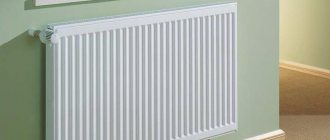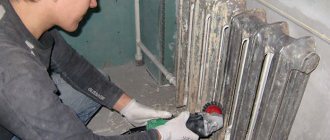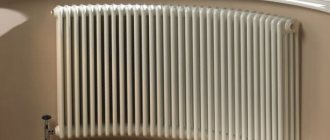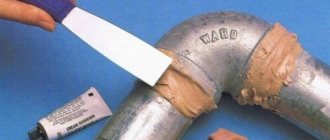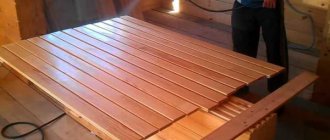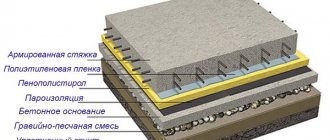Here you will learn:
- Features of centralized heating systems
- How to choose new batteries
- Preparing to replace heating batteries
- Procedure for replacing heating batteries
- When is the best time to replace batteries?
Owners of apartments in multi-storey buildings often complain about the poor quality of heating - the apartments are constantly cold. Irritation is also caused by the terrible appearance of outdated heating batteries, clearly asking for a landfill. In order to get rid of irritating factors and improve the quality of heating, drastic measures are needed. Replacing heating batteries in an apartment will be one of the measures to solve problems with the heating system.
What will we talk about in this review?
- About the features of centralized heating systems;
- About choosing suitable batteries;
- About the procedure for replacing heating batteries.
If you know how to choose heating batteries and how to replace them, everything will take a few days at most.
Features of centralized heating systems
Replacing heating radiators in an apartment will require certain knowledge. In particular, you need to know about the operating features of heating systems in apartment buildings. Here, batteries and pipes are exposed to high pressure - it allows the coolant to be pushed through numerous radiators, connections, bends and transitions. Gravity flow is impossible here, so powerful pumps are used to create increased pressure.
In high-rise buildings, the pressure in centralized heating pipelines reaches 15-20 atmospheres. Therefore, radiators used in apartments must withstand such pressure without breaking into separate pieces. If you install an unsuitable radiator in an apartment, then when the coolant is supplied, it will simply burst - the coolant will flood the floors and appear on the neighbors’ ceilings.
If you choose the wrong heating radiator, it can rupture, resulting in damage not only to your property, but also to the property of your neighbors.
But that’s not all, since in centralized heating systems water hammers are often observed - sometimes they are even audible when the elastic coolant hits the pipes with force, causing them to shudder. The pressure during water hammer is 2-2.5 times higher than the nominal values. If there is a fragile battery in the heating system, it will rupture - with all the ensuing (in the literal sense of the word) consequences.
It is impossible not to note the quality of the coolant in the heating system. It is far from ideal, as heating engineers are well aware of. The coolant contains:
- Aggressive salts formed upon contact with metal and other elements of the heating system;
- Chemical impurities used to clean heating systems from scale and rust;
- Small mechanical impurities - when mixed with water, they literally undermine pipes and radiators, leading to mechanical damage.
What flows through the pipes of centralized heating systems can hardly be called water - it is a rather aggressive liquid that corrodes metals that are not resistant to corrosion.
Some interesting tips
If you decide to replace old batteries, it won’t hurt to think about installing a faucet, either regular or with a thermal head. In the first case, you can manually regulate the coolant flow, in the second, this will be done automatically. But if a thermostat is installed on the radiator, it does not need to be covered with a decorative screen.
The thermal head on the shut-off valve makes it possible to change the amount of coolant so that the temperature in the room is always high enough
This will lead to data distortion when measuring temperature. It is worth noting that thermostats can only be installed in single-pipe systems. In any case, at least shut-off valves must be installed at the inlet and outlet of the radiator, if they are missing.
This will allow you to disconnect the radiator from the system to clean or replace it, regardless of the season. The thermal power reflected in the battery data sheet does not always correspond to the declared one. If you increase the number of sections by 10%, you can improve the situation.
How to choose new batteries
Replacing heating batteries begins with their purchase. In stores we can find a variety of radiators, ranging from cast iron to bimetallic. Which of these is suitable for residential installation?
Cast iron batteries
It should be noted that cast iron batteries are quite often found in low-rise apartment buildings. And consumers are actively getting rid of them - they are outdated and do not meet modern requirements. They can withstand high pressure, but they are not suitable for installation in high-rise buildings . Even if you choose a modern designer model, it will not be able to please you with its high efficiency - low heat transfer and high heat capacity affect it.
Steel panel and tubular batteries
Steel batteries are used to heat 9-16-story buildings, but they cannot be called resistant to high pressure. In addition, they are often broken by water hammer that occurs in centralized heating systems. Modern panel steel models are not recommended at all for residential installation - they are only suitable for low-rise housing with autonomous heating, where there is no high coolant pressure. As for tubular models, they are quite durable, but are very rarely found on sale.
Aluminum batteries
Aluminum radiators are not suitable for heating apartments under any circumstances . The thing is that aluminum cannot withstand high pressure and is completely unable to withstand water hammer. As a result, the batteries rupture already during filling and initial testing of the heating system. Aluminum is also susceptible to corrosion, which occurs due to exposure to aggressive coolant - in such conditions, their service life will not exceed 3-4 years.
Durable bimetallic radiators
Bimetallic radiators are the best choice for installation in apartments. Here are their advantages:
- Light weight and easy to install;
- High heat transfer and minimal inertia;
- Resistance to aggressive coolant;
- Resistance to high pressure in pipes;
- Resistance to strong water hammer.
Many manufacturers of bimetallic batteries confidently claim that their products can withstand pressure surges of up to 50 atmospheres. This indicator is really significant, so these batteries are recommended for residential installation.
The basis of bimetallic batteries are reliable and durable metal cores through which the coolant flows. An aluminum “jacket” is placed over the cores, dissipating heat in the rooms. Aluminum here has no contact with the aggressive coolant and is not subject to pressure - strong and durable steel takes on all the hardships.
In addition, bimetallic radiators have an attractive appearance - they are much more beautiful and compact than their cast-iron counterparts. As for heat transfer, it is 70-80% higher - the house will be warm and cozy. Combined with ease of installation, all this makes bimetallic batteries the best solution for residential installation.
The only disadvantage of bimetallic batteries is their high cost. But on sale you can always find models from little-known manufacturers who practice more affordable pricing policies and offer batteries at affordable prices.
Read about which heating batteries are best to choose for a private home in another article on our website.
Installation technology.
Let us consider in detail the technology of installation with steel pipes, as the most common case. There are two options here, welding or threading. The optimal technology is gas welding, since in comparison with threads there are no vulnerabilities in the form of slips, without which no installation on a threaded connection is possible. In short, pipes usually always leak, since they are subject to loads from thermal expansion, and installation with a large number of fittings does not look as attractive as a welded solid steel pipe.
Details in the photo of the installation of the radiator on the thread and our modification with gas welding.
As for gas welding in comparison with electric arc welding, gas welding has 3 advantages:
— the ability to correct inaccuracies in the installation of builders by heating and bending fragments of the riser using a gas burner.
— absence of slag inside the pipe, narrowing the cross-section.
- no sparks from molten metal.
Preparing to replace heating batteries
We have already completed one of the most important parts of the work - we have selected suitable heating batteries by choosing a bimetal. Now we need to understand the stages of further work. Replacement of heating radiators is carried out through the housing office, officially, since the general house heating system is affected here. The procedure is performed in several stages:
- Submitting an application to the Housing Office;
- Agreeing on the date of work;
- Checking the integrity of the heating system.
Under no circumstances should you turn off the heating riser yourself; this should be done by specialists from the housing office.
In order to begin replacing batteries, you must write an application to the Housing Office. It must be said that we do not have the right to independently control the shutdown and drainage of the coolant from the risers - this is done by specialist plumbers. After submitting the application, you need to agree on a date for the work. On this day, the specified house will be visited by a master plumber who will drain the water and carry out further checks. You also need to agree with the specialists who will carry out the work.
If you have experience in replacing heating batteries, then you can carry out interior work yourself. To do this, you need to prepare the necessary tools and pipes, purchase suitable radiators, think over a diagram for connecting new radiators (the old diagram may not fit modern radiators. We recommend replacing heating batteries using gas welding. This may seem difficult to some, but gas welding allows you to achieve exceptional quality connecting seams.
If you do not have experience replacing batteries, you should entrust the procedure to an experienced installation team. They will complete all the work in the shortest possible time, check the integrity of interior elements and hand over the results to the customer. The cost of replacing heating batteries in an apartment will be indicated before the installation and dismantling work begins - the price for services is specified in the estimate.
Can't find a good team of specialists? In this case, you can contact the Housing Office - they can provide their own specialists who will carry out all the necessary work and check the integrity of the system together with a plumber.
Preparatory stage
After the old heating equipment is dismantled, markings for new batteries are applied to the wall, indicating the mounting locations for the bracket. It is produced based on the size of the radiator and the distance between sections. The building level will help you draw verticals and horizontals correctly. For ease of work, you can mark the outline of the battery on the wall.
In the places where the brackets will be attached, holes must be drilled for them. Based on the type of fastening of the brackets, they are screwed or driven into the wall. If cracks and deep chips have formed in the wall, before installing the radiators on the brackets, it is necessary to eliminate all surface defects by cleaning and covering it with a cement composition.
You can increase the heat transfer of the batteries and avoid pointless heating of the walls if you attach foil insulation behind the radiator. It is laid according to the size of the battery, covering the space up to the windowsill. As a result, heat waves will be directed into the room.
Procedure for replacing heating batteries
To replace an old radiator, first close the riser, then cut off the radiator, install a new radiator, not forgetting to install three taps into the system to simplify maintenance of the system in the future.
Replacing heating batteries in an apartment begins with a specialist from the housing office disconnecting and draining the riser - all work is carried out in the absence of coolant. As soon as the heating riser is drained, we begin work. Using a welding machine or grinder, we cut off the old heating batteries and send them to the scrap yard. We install new bimetallic batteries under the window sills and level them.
Next, we prepare the pipes - they will be used to make the connection. If old tubular steel batteries were installed in the apartment, then the inlet and outlet pipes will be located too close to each other. Therefore, we need to space them out so that they match the location of the inlet and outlet holes on the new radiators - this is done using sections of curved metal pipes.
Together with the radiators and pipes, we build in taps that allow the radiators to be disconnected from the heating system, even if it is on. To do this, we place a jumper on each battery, which will be responsible for the unhindered passage of the coolant. Three taps are also installed here - on the jumper, at the inlet to the battery and at the outlet. If the battery suddenly fails or starts leaking, you can replace it without notifying the housing office . Also, this scheme will allow you to regulate the degree of heating of the rooms - the presence of taps makes it possible to individually adjust the temperature in each room.
Please note that if you install 3 taps, you are responsible. Under no circumstances should you turn off the taps in front of the heating radiator and the tap on the jumper at the same time. Otherwise, you will block the riser and stop the circulation of hot water in the pipes, which will lead to freezing of the entire heating system in your home.
To test the heating in an apartment, a special pump is used, and the process itself is called pressure testing.
The presence of taps has another advantage - you can easily replace a section of the heating radiator. To do this, open the tap on the jumper/bypass, close the inlet and outlet taps, remove the battery and replace the section (true for dismountable batteries).
As soon as the connection work is completed, you need to check the integrity of the system. Otherwise, the coolant will flood not only your apartment, but also the apartment of the neighbors below - they are unlikely to burst with delight when they find yellow spots and dripping water on their ceiling. The inspection is carried out by a housing office specialist.
Do not throw away documentation from the equipment used - remember that the Housing Office may require these documents at the stage of submitting an application and agreeing on the date for the work. The whole point is that the equipment used for replacement must meet certain requirements and not become an obstacle to the operation of the general heating system.
Radiator placement rules
Batteries are most often placed under the window to compensate for heat loss when cold air enters through the opening.
In this case, the following distances must be maintained:
- from the wall - 20 mm;
- from the floor - 120 mm;
- from the window sill - 100 mm or more.
It is advisable that the window sill does not overlap the radiator too much for effective air circulation in the room. These figures are guidelines only and may be higher or lower, although noticeable changes may affect the heat output of the structure.
The heat output of the battery may vary depending on the installation method. If the distances are maintained correctly, the device will give off more heat
To improve the situation, it is recommended to cover the wall behind the radiator with a reflective material, such as penofol. Although some masters consider this measure useless. But a beautiful decorative screen will become an obstacle to warm air, it is better to refuse it. Modern batteries look quite attractive; there is no point in hiding them.
When is the best time to replace batteries?
Most repair issues are resolved in the summer. At the same time, procedures for replacing batteries are performed. The thing is that in summer the heating system is inoperative, so draining the riser will not cause any trouble. You can easily replace old batteries with new ones, a specialist will fill the system with coolant, check its integrity - the system is ready for further use.
Replacing heating batteries for your apartment in winter is complicated by the fact that your neighbors will be left without heat - they are unlikely to be happy about this fact, given that many have small children. In the cold season, when the heating systems are on, a maximum of 2-3 hours is allocated for replacing batteries - it is unlikely that anyone will allow a long shutdown of heating. All this is labor-intensive and requires coordination of each step with the Housing Office. Therefore, we recommend that battery replacement work be carried out during the warm season .
The exception is the replacement of heating batteries in an apartment in winter if accidents occur - in this case, the heating will be turned off without any questions asked, in order to restore the functionality of the system as quickly as possible and supply heat to the apartments.
Convenient time for work
The period of time when it is better to change heating batteries is the period between the end of one heating period and the beginning of another. During the heating interval, hydraulic tests of the system can be carried out. It is important to obtain information in advance from the management company about the timing of the tests in order to schedule battery replacement for other days.
It is better to change radiators in the summer
Due to an emergency situation, it may be necessary to quickly change heating devices. For a privatized apartment, emergency replacement of radiators is a paid service, since their performance must be monitored by the owner of the apartment and promptly notified to the operating company about leaks or physical wear and tear of old batteries that have expired.
Connection diagrams
The radiator has holes at the ends for connecting pipes supplying coolant to the radiator and discharging it (return). The following connection diagrams exist:
Lateral
The coolant supply pipe is connected to the upper hole at the end of the radiator. The coolant passes through all sections from top to bottom and is discharged through a return line connected to the lower hole at the same end.
A Mayevsky valve is installed in the upper hole at the other end to bleed off excess air. A plug is placed in the remaining lower hole.
- It is used in apartments with a single-pipe coolant supply system.
- The length of the radiator is no more than 1 m (heat loss increases with the number of sections).
Diagonal
The coolant supply is through the upper hole on one side, the return outlet is through the lower hole on the other side of the radiator. The coolant flows diagonally from top to bottom.
- Effective heat transfer with any number of sections.
- Allows you to connect several radiators in series.
Lower and saddle
The supply pipe enters the lower hole on one side, the return pipe exits through the lower hole on the other side of the heating device.
Photo 1. Bottom heating radiator connection diagram: pipes pass between the floor and the radiator.
- Used for hidden pipes in the floor.
- Thermal efficiency is 30% lower than diagonal (coolant stagnation in the upper part of the radiator).
Reference! Most often in private homes, heating pipes are laid along the wall between the radiator and the floor. Near the radiator, upward bends are made with a diagonal connection.
Incorrect calculation of the number of sections
Using a tap, you can lower the heating temperature if it suddenly turns out to be too high for the room, but you cannot raise it above that achieved with the tap fully open. In apartment buildings with centralized heating, the coolant temperature varies. If for some reason it turns out to be low (this often happens), it will be impossible to raise the air temperature inside the apartment. Now, if only there were a little more sections in the radiator...
Calculation of radiator sections when replacing is made based on the basic coefficient, which is equal to 1.4 per sq. m. It can be done with the help of store consultants when purchasing a radiator. But here the following error awaits buyers: the calculation is carried out based on the average heating temperature of the coolant, and there are situations, as already mentioned, when the temperature of the water inside the batteries drops below. In order not to experience discomfort, the number of sections should be slightly larger than calculated by the average coefficient.
Useful tips
Regarding rental housing, the picture is unclear. Thus, according to Government Decree No. 491 of August 13, 2006, heated elements are included in the common property of the house. A Art. 65 of the Housing Code of the Russian Federation states: the landlord is obliged to monitor the proper condition of common property and repair it as necessary. In fact, management companies and housing offices carefully hide this information, encouraging residents to replace heating devices at their own expense. Those who wish to assert their rights can apply to the court. But there is certainty regarding privatized apartments. There, the repair of utility networks is the responsibility of the owners.
If the radiator bursts, you must immediately call the operating organization (UK or Housing Office). In some entrances you can find a telephone number on the wall to call an emergency team. The second thing you need to do before the repairmen arrive is to localize the leak (throw a blanket over the battery) and try to collect the water in a placed container (basin). The third step is to turn off the water. If there is no shut-off valve in the apartment, you will have to turn off the entire riser in the basement, the key to which is usually kept by the plumber on duty. Read about the cast iron heating and cooking stove on our website.
